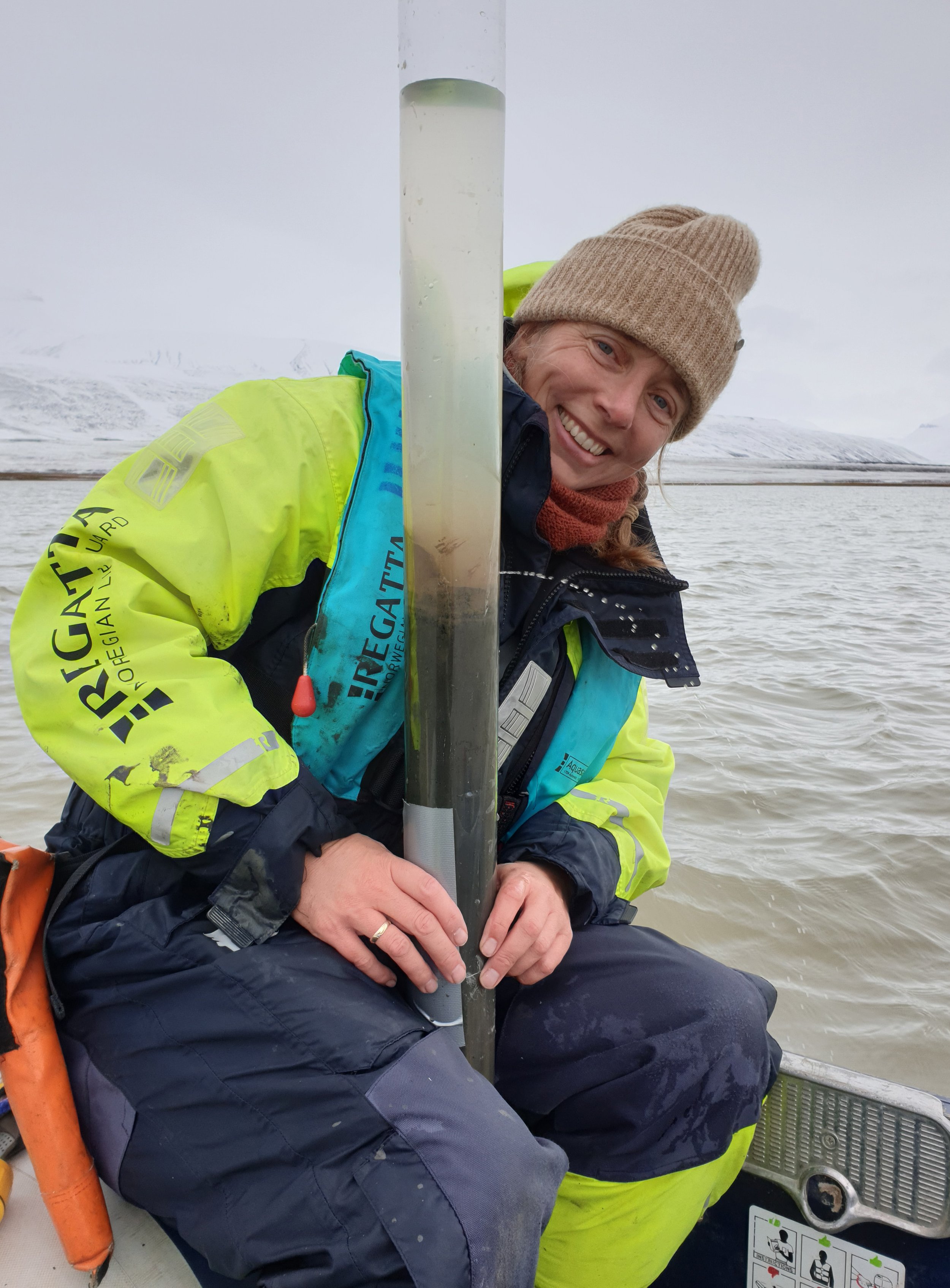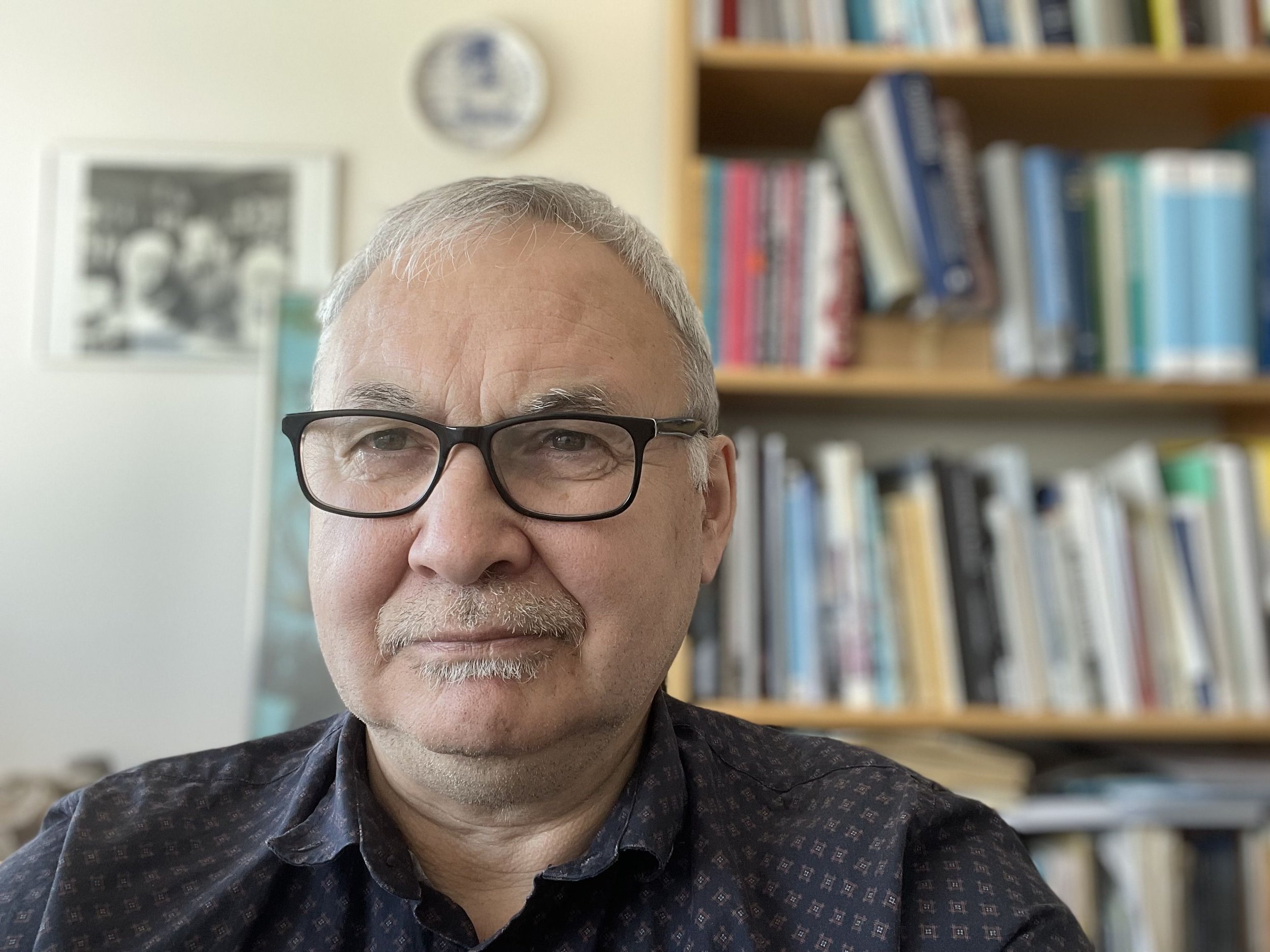-

Ray Bradley, UMASS Amherst
Ray is a paleoclimatologist. He studies how the climate has changed over time, and what might have caused those changes. He's spent a lot of time in the Arctic--northern Canada, Greenland and Arctic Norway (Svalbard) taking sediments from lakes. These provide a record of past environmental changes in those regions, from the end of the last Ice Age to the present day. Global warming has greatly affected the Arctic so that some of the small ice caps he worked on in the past have now completely disappeared.
-

Frederik Fuuja Larsen, Greenland National Museum
Fuuja is a curator at the Greenland National Museum & Archives in Nuuk, specializing in Paleo-Inuit archaeology. He has a Masters degree in Culture & Social History from Ilisimatusarfik, the University of Greenland. He has participated in numerous archaeological surveys and excavations throughout Greenland over the last 25 years.
He was born and grew up in Maniitsoq, a little town north of Nuuk, the capital of Greenland. He has a passion for outdoor life. He and his family have a boat and a cabin out in nature, where they hunt and fish.
-

Nick Balascio, William and Mary
Nick is a paleoclimatologist whose research focuses on reconstructing climate and environmental conditions in Arctic and alpine regions. He specializes in the analysis of lake sediment records and how they can be used to examine past climate changes as well as prehistoric human-environment interactions. He is an Associate Professor of Geology at William & Mary, Virginia (USA).
-

Christian Koch Madsen, Greenland National Museum
Christian considers himself mainly an Arctic landscape archaeologist, i.e. a researcher who works to understand how different people in the past lived in, experienced, and interacted with the environments and landscapes they were settled in. Practically, this means that he travels across Arctic landscapes to visit a lot of different archaeological sites to map and date them, so we can understand when and how each site was used, by how many, and how use may have changed over time as people responded to changes in their environment, sometimes on millennial scales, at other times in the face of rapid climatic and environmental change.
-

Bianca Perren, British Antarctic Survey
Bianca is a paleoclimatologist and paleolimnologist with a specialization in polar environmental change. Her work focuses on reconstructing environmental changes using diatoms from remote lake ecosystems in Greenland, the Canadian Arctic, Svalbard, Alaska, and the Subantarctic islands.
In her spare time, she is a painter, printmaker, zodiac driver, and educator, teaching young people about polar climate change.
-

Billy D'Andrea, Lamont Doherty Earth Observatory
Billy is an Earth Scientist who investigates the natural changes in Earth’s climate and sea level throughout the past. He specializes in the use of molecular fossils preserved in lake sediments around the world to quantify past temperature and precipitation changes, and to document patterns of prehistoric human land use.
In his spare time he is a mandolin and guitar player, nature photographer, and kayaker.
-

Alan Condron, Woods Hole Oceanographic Institute
Alan is a climate scientist who uses numerical models to investigate the causes of past and future abrupt climate change. He is especially interested in how changes in sea ice, icebergs, and freshwater runoff in the high latitudes alter ocean circulation patterns. He is also interested in knowing if icebergs can be towed to arid coastal regions to provide drinking water.
Outside of the office, Alan enjoys canoeing and paddleboarding, trying to ice skate, and camping. He also keeps ducks and chickens.
-

Jostein Bakke, University of Bergen
Jostein is a Quaternary geologist specialized in lake sediment studies.
The number-one target for his research has been to develop better tools for describing and differentiating the various sediment components deposited in glacial-fed lakes and to up-scale those results to interpretable climate signals. He has worked extensively with lake sediments and paleoclimatic reconstructions with multi-decadal to centennial resolution and has developed new methods for reconstructing glaciers. In the last few years, he has started to use lake sediments as an archive for geohazards such as flooding and avalanching and has applied new methods such as DNA and leaf waxes on the sedimentary archives.
-

Inger Alsos, University of Tromsø
Inger is the leader of the Ancient DNA lab and the Aurora Centre for Arctic Ecosystem Genomics at The Arctic University Museum, UiT - Arctic University of Norway (UiT). In her research, she has focused on past and potential future distribution of arctic and subarctic plants. She has combined genetic data (fingerprinting, shotgun sequencing, and ancient DNA), species distribution modelling, and fossil data to explore dispersal routes, colonization frequencies, and long-term genetic effects of climate change.
-

Hans Lange, Greenland National Museum
Hans Lange is a curator at the Greenland National Museum & Archives with a MA in Culture & Social History from the University of Greenland (2013) and BA from Aarhus University, Inuit Culture & language in Denmark (1982). Over the past 40 years, he has participated in archaeological fieldwork at several sites in South, West and Northwest Greenland, Inglefield Land, North East Greenland, Holm Land, Amdrup Land, Frigg Fjord, Ellesmere Island in Canada and Kotzebue, Alaska. Hans' professional interests include Paleo-Inuit and Thule Culture Inuit history, Inuit language, stories and myths and the revival of traditional Greenlandic practices in modern Greenlandic society.
-
Tobias Schneider, Lamont Doherty Earth Observatory
Tobi is dedicated to investigating lakes and their sediments in order to unravel the local and regional environmental, climatic, and pollution conditions of the past of these crucial ecosystems. He was involved in fieldwork campaigns in Central Chile, the Ecuadorian Andes, USA, Switzerland, and South and North Greenland. He applies a wide range of sedimentologic (e.g., grain size distributions), geochronologic (e.g., radiocarbon dating), (bio-) geochemical (e.g., lipid biomarkers, heavy metals), and physical methods (e.g., hyperspectral imaging, and X-ray fluorescence measurements) on lake sedimentary records for the reconstruction of past local climatic and environmental conditions (Holocene-length, ~12,000 years BP). These reconstructions additionally aim at contributing to the understanding of human-environment interactions. He is currently a Swiss National Science Foundation (SNSF) Postdoctoral fellow at the Lamont-Doherty Earth Observatory, Columbia University, New York
-

Inaluk Schmidt Jacobsen, Greenland National Museum
Inaluk is studying for her BA in social anthropology at the University of Copenhagen with additional courses at the Department of Cultural and Social History at the University of Greenland, where she will continue her studies towards an MA in Social Science.
Inaluk is an Inuk from Nuuk and is well used to the outdoors where she enjoys hiking, hunting, fishing and generally being. She has experience in fieldwork in relatively isolated locations with her work as a student assistant collecting data at sea for the Greenland Institute of Natural Resources.
She will be a part of the research project as a student assistant for the Greenland National Museum & Archives and will take part in GPS mapping the field area as well as collecting aerial photos, which will be her first archeological fieldwork.
-

Aart Verhage, Norwegian Water Resources and Energy Directorate
Aart has a MS in Quaternary Geology from the University of Bergen. He works at the Norwegian Water Resources and Energy Directorate (NVE) as manager for one of five regional offices in Norway – the Western region. Their main responsibility is to reduce risk of damage on buildings and other infrastructure associated with natural hazards as avalanches, landslides, erosion, and flooding through protection measures, public knowledge, information, and legislation.
He has extensive field experience from various trips to Svalbard, Kerguelen Island in 2019, various coring campaigns in Norway, and 50 years of Norwegian all year outdoor activity including climbing, kayaking, hiking, and skiing.
-

François Lapointe, UMASS Amherst
François is a limnogeologist and paleoclimatologist with special focus on annually laminated sediments (varves) from Arctic lakes spanning the Holocene (~12,000 years BP). He applies a range of tools to extract annually resolved parameters that include micro-fluorescence-X ray and grain-size analysis on thin-sections using scanning electron microscopy. He is especially interested in uncovering climatic signals in varves to shed light on the causes of abrupt environmental change. As Arctic warming can be amplified or dampened by natural climate mode of variability, investigating large-scale climatic teleconnection is also an important topic of his research.
-

Redmond Stein, Lamont-Doherty Earth Observatory
Red is a graduate student studying organic geochemistry and paleoclimatology. Their research focuses on the analysis of organic biomarkers in lake and wetland sediments, which preserve records of past climate change and of prehistoric human activity, and is working on projects in the eastern South Pacific (Rapa Nui/Easter Island) and northern Greenland.
In their free time, Red enjoys hiking and swimming in non-Arctic lakes, listening to jazz music, and feeding corn husks to their guinea pigs. They recently participated in a fieldwork campaign in northeast Greenland and are excited to return as part of the Wandel Dal Project.
-

Dominic Hodgson, British Antarctic Survey
Dominic leads the Ice Sheets and Climate Change team at the British Antarctic Survey (BAS). He has led multiple field campaigns to remote locations in Antarctica and the sub Antarctic and has published papers on glacial, climate and environmental history, glacial geomorphology, sea ice history, geochronology, sea level, limnology, palaeolimnology, biological responses to climate change, biodiversity and evolution, aquatic and terrestrial biology, subglacial environments and life in extreme environments. He was awarded the Polar Medal for outstanding achievement and service to the UK in the field of Polar Research and has a visiting professorship at the University of Durham.
